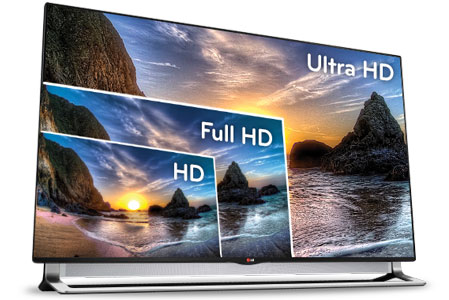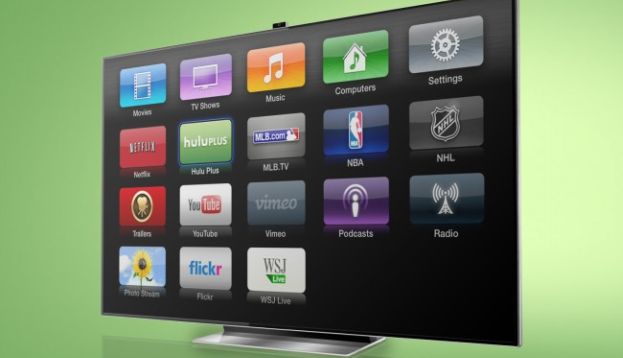Television programming is undergoing a revolution, with Netflix being nominated for Emmys and even Amazon preparing original programming. Apple and Google are continuing attempts at changing the way people view TV, even while digital media is poised to see more viewer time than TV. Meanwhile, the last great innovation that would sell zillions of TVs — 3D — has crashed and burned as consumers decide they don’t care to pay extra for it. Sony alone has lost over $8.5 billion in television manufacturing over the past decade, and other TV makers aren’t doing great, either.
All of this may be about to change, as the next great innovation in TV looks like it may arrive far faster than anyone suspected. Unlike 3D, this innovation actually has a good chance of getting adopted, and in a big way. It’s 4K TV, also known as Ultra HDTV — a TV picture with a resolution double that of current HDTV in both directions resulting in 3840 x 2160 pixels. As we all know, more pixels means more eye-melting goodness.

Ultra HDTV’s were all over this year’s CES show, but mostly they were very large (84″ and above) and extremely expensive ($10,000 to more than $20,000). Now, rapid manufacturing advances is driving down the cost of Ultra HDTV to the point where a Chinese manufacturer is bringing a 55″ Ultra HDTV to market this holiday season for only $999. Tablets and PCs are already moving towards Ultra HD resolution, with Apple’s MacBook Pros sporting 2880 x 1800 resolution to critical acclaim.
So why will it succeed where 3D TV hasn’t No glasses are needed, for one thing. The difference is easily communicated, readily understandable and can be demonstrated in a store without any special effort. The big drawbacks right now are the price and the content — both lack of 4K content and the distribution of it.
The lack of content isn’t that big of an issue since current films are mostly shot in 4K resolution or better. Current movie content could be re-mastered for Ultra HDTV, and content created for HDTV could be upscaled. Yes 4K movies will take up a lot more space, but higher-capacity Blu-Ray drives are already in the works. Codecs have already been demonstrated that will compress 4K video streams to a manageable level for distribution, not much greater than HDTV streams.
How does the advent of Ultra HDTV impact gaming Sony is getting ready for Ultra HDTV in a big way, hoping it will revive the profits of Sony’s TV business. The PS4 is said to be ready to handle 4K output, bringing gaming to Ultra HD quality (although at a lower frame rate than is possible on HDTV). Sony’s hoping that when Ultra HDTV becomes a significant market segment in a couple of years (or three), the PS4 will be ready to game right along with it.
Games created in 3D (which describes most console and high-end PC titles these days) are mostly resolution-independent. Interface elements might have to be revised, but that’s relatively easy. The vast expanse of the battlefield will just get bigger; you’ll see a much larger field of action. Many high-end PC games already let you spread a game across several monitors, though usually you’ll need a pretty beefy graphics card or two to handle that with all of the graphics options turned up to maximum. Overall, the transition for gaming to Ultra HDTV will be simpler than most technology transitions.

Games could also be shown in a somewhat smaller window that allows for multi-tasking alongside, the way Microsoft showed in its Xbox One demos. Imagine playing a full HD game, or maybe larger than yet, along with your friends in HD video chat windows along side. That’s truly social gaming, with your friends’ virtual presence giving you the next best thing to them being in the same room with you.
Here’s where it starts to get really interesting: Apple’s rumored iTV may actually get real, and have a real chance to sell. It never made much sense in the original iTV rumors, which had an Apple-labeled HDTV that would sell for $2000. Most people have an HDTV, so would they really buy an Apple HDTV just to get some features they could already get by buying an Apple TV Now, though, stir in the rumors that Apple is sourcing Ultra HD screens. Suddenly the idea could make sense. Apple’s incredible manufacturing power would give it an edge on pricing and availability, just the sort of edge Apple loves to have.
Picture this scenario: Apple goes to an Ultra HDTV screen maker and dumps billions of dollars in cash on them, buying up all the factory capacity for the next two years. This locks in Apple’s supply at a great price, and prevents other manufacturers from getting any Ultra HDTV screens at any price. This is exactly how Apple started the iPad, which gave Apple a market share lead in tablets that still hasn’t been overcome.
So Apple sells an iTV for under $2000 that features Ultra HDTV resolution in a 60†screen, and voice/gesture control, and perhaps finally some breakthrough deals with content providers to make it easy to find and display any content you want. At the same time, Apple opens up an App Store for iTV, and offers a new Apple TV that brings these capabilities to your current HDTV (sans Ultra HD resolution, of course). Throw in cloud-based DVR features to boot. Add a slew of Ultra-HDTV games that start flowing from game publishers eager to be in on the ground floor of the next gaming revolution. Result: The entire landscape of TV changes, with a massive impact on gaming as the App Store finally arrives in the family room.
It’s a good time for game developers, marketers and publishers to be flexible, creative, and ready to move as the market changes.

